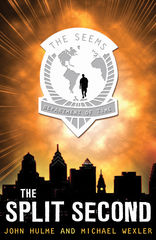[button color=”black” size=”big” link=”http://affiliates.abebooks.com/c/99844/77798/2029?u=http%3A%2F%2Fwww.abebooks.com%2Fservlet%2FSearchResults%3Fisbn%3D9781599902999″ target=”blank” ]Purchase here[/button]
The second book of The Seems re-introduces us to a 13-year-old Fixer named Becker Drane. In our world (a.k.a. The World, in capital letters), he’s an ordinary, baseball-playing middle-school student with a tiresome younger brother and a couple of parents who are desperate for some vacation time. In the world that makes The World go round (a.k.a. The Seems), Becker is a member of the crack team of trouble-shooters who take charge when something goes out of whack. What do you do when the landscape artist in charge of creating all The World’s sunsets goes on strike? Call a Fixer! What do you do when someone sets off a Time Bomb that threatens to age the entire World to a pile of ashes before its time? Well… That could be tricky.
The “somebody” who does this is a terrorist organization known as the Tide, whose members include one of Becker’s buddies from Fixer training–see The Glitch in Sleep for details. The Tide, and its mysterious leader Triton, aim to overthrow the Powers That Be and replace The World as we know it with something designed according to their own ideas. Destroying everything and everyone may or may not be part of their plan, but it will be the result if the Essence of Time unleashed by splitting a Second contaminates populated areas of The World.
To fix this problem, Becker will have to face his own weaknesses, witness the death of a friend (twice, actually), swim through a puddle of melted Frozen Moments preserving the peak experiences of fifty different people, face a ruthless rival in hand-to-hand combat, and deploy a plethora of gadgets with whimsical trade names. A healthy appreciation for puns can be enough, by itself, to make this book a pleasure to read. But the danger is genuinely exciting. The fantasy concept is engrossing, even if it doesn’t stand up to serious scrutiny. The hero is an intriguingly flawed but appealing character. And although The Seems is quite silly at the level of detail, it might trigger some interesting classroom discussions about philosophy and religion.
The authors know how to pace the paying-out of tension and mystery. They know almost as well how to juggle the storylines of several equally interesting characters. (To be honest, there is one character who could have been deleted from the book for all his usefulness to the plot.) They have designed a romp through time so diaboloically clever that I can hardly wait to find out what their third book holds. Now available in paperback, its title is The Lost Train of Thought.

